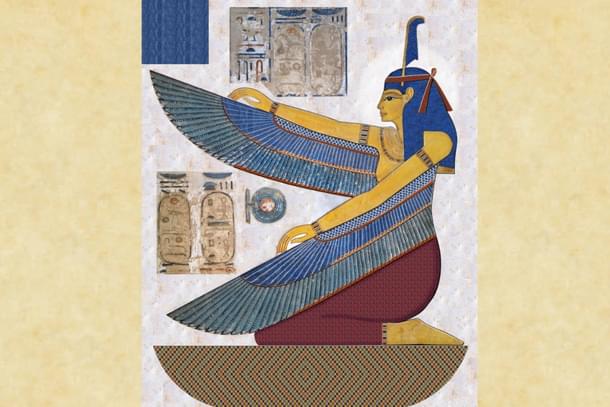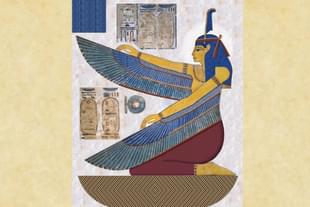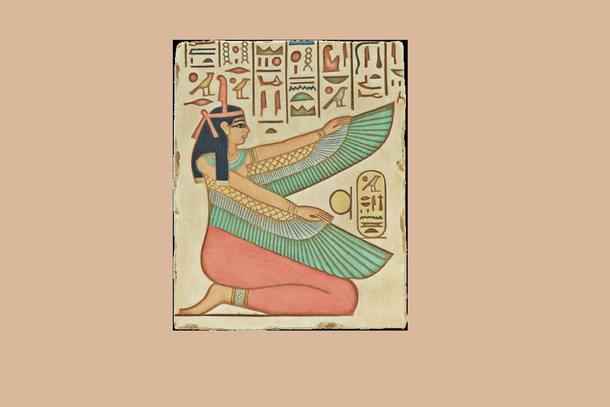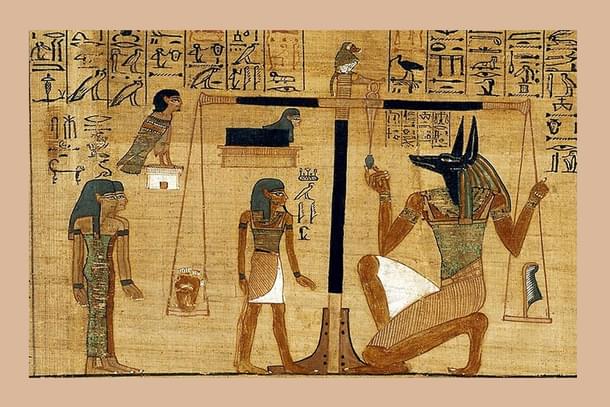Culture
Navratri Notes: Maat, The Goddess of Cosmic Order, Breath Of Life, And Justice
Aravindan Neelakandan
Oct 05, 2024, 05:43 PM | Updated Oct 07, 2024, 12:22 PM IST
Save & read from anywhere!
Bookmark stories for easy access on any device or the Swarajya app.


She is the universal order that flows river-like through the entire cosmos. And in creation it is She who breathes life into existence. As life evolves and human societies arise, She manifests in the societies as Righteousness and Justice.
Through Righteousness, She bequeaths peace and prosperity. She knows all the secrets each heart holds. She knows the deeds, good and bad. She judges each soul in the Hall of Truth.
In the banks of river Nile to the seers of ancient Egypt, She revealed Herself as Maat, the winged Goddess. Her images show Her either as winged or as wearing the feather of ostrich which in turn is the symbol of Truth.
In the Egyptian ceremony of weighing the heart in the hall of Truth, it is against this feather of Truth that the heart of the individual is weighed.

Thus Maat is the Divine Feminine which is at once an impersonal eternal principle that can be meditated upon. She is the principle which sustainable and enduring civilisations are founded upon. She is also a very personal Goddess whom a Bhakta can relate to.
Maat as a Divine Feminine concept was a great achievement that the ancient Egyptians arrived it. It is far more holistic than the latter faith-based laws.
Egyptian seers related the manifestation of order in human society with the divine impersonal order in the universe. But how could humans understand and perceive such an impersonal order?
Maat made the impersonal universal order visible to the humans. Rulers and judges became the Sun of the Egyptian lore who upheld Maat so that the universe could function properly.
Sure enough that was a geocentric understanding of the sun moving from east to west and given birth every morning. But Maat as a Divine Feminine principle shows the divine strength within to grow along with the explosion of scientific understanding of the universe.
The Sun does not revolve around the earth as ancient Egyptians thought. But surely Maat is the basis of all existence—physical, biological, psychological, social, political and ecological.
True religion does not base itself on the limited knowledge and ignorance of humanity. It does not invent the God of the gaps. Rather, the Goddess is ever expanding with our knowledge. Our expanding knowledge does not diminish us but rather make Her even more mysterious, relevant, and ever-charming.
One can recognise Her in all pagan societies. In India She is Rta and Dharma. In China She is Tao. She is the dance of the fire of Heraclitus. In the amphora seals of 15th century BCE, She is called the ‘Good Goddess Maatkare’ which means She is the ‘Truth the soul of Re’. Re is another name for Sun God. She was the Logos of the Greeks before it was appropriated by Christian theology.
A very important imagery of Maat in Egyptian religion is that She is the plinth of the royal throne. In other words it is on the ever vigilant principle of Maat as the Goddess of Truth and Justice that the temporal power of the king rests. He is only in this sense a living god. He has to carry Maat in his heart failing which he would cease to be a ruler.
Maat is also the nourishment of the Gods. As Egyptologist Henri Frankfort points out, ‘in the concrete imagery of the Egyptians, the gods are said to live by Maat, which means: The powers immanent in nature function in accordance with the order of creation.’

A great contribution to the idea of religion that the Goddess Maat tradition gave was the vision of post-mortem judgement along with rewards and punishment in afterlife. Egyptian Marxist Samir Amin who famously introduced the term ‘Eurocentrism’ in the book of the same name points out that it was Egyptian religion which pioneered ‘the concept of eternal life and immanent moral justice, opening the way for humanist universalism’ and that ‘the universalist moral breakthrough of the Egyptians is the keystone of subsequent human thought’ in the Western lineage of humanity.
In fact unlike the faith-centred judgement scenarios of monopolistic religions, the judgement in the case of Maat is essentially character-deed based than faith based. Primacy was given to conduct, not religious belief. From the judgement of Maat to the judgement day scenarios of later monopolistic religions there is quite an ethical devolution.
The basis of this ‘moral breakthrough’ of ‘humanist universalism’ is the Goddess Maat. However there is an important difference in the after-life conception of Maat tradition. The spirit is not given any alluring carnal prizes in the after life by an almighty God as in certain later religions. Rather the soul that held Maat in the heart expresses that ‘it may assume whatever form it wants, in whatever place it spirit wishes to be.’ The declaration is the expression of all Divinities realised in the self:
I stand up like Horus, (beloved son and avenger of his father). I sit down as Ptah (Creator who laid the foundations of the universe). I have grown as strong as Djehuti (wisdom exalted). I have become as powerful as Atum (Ra as the perfecter). I have entered as a falcon and come forth as a phoenix. Morning star make way for me, so that I may adore Ra in the (beautiful paradise of) the West.
Today among Afro-movements there is a need for an indigenous spiritual heritage. Rightly, the ideologues and activists of Black Movement who want to think outside the boxes of Christianity, Islam and Marxism, zero in on Maat and Maat-related ethics.
Maulana Ndabezitha Karenga (born Ronald McKinley Everett born 1941) was a Black activist-scholar who moved away from Malcolm X because of his own emphasis on rootedness in African spirituality.
He was instrumental in creating Kwanzaa, an annual celebration of African-American culture from December 26 to January 1, culminating in 'Karamu' a communal feast.
He has been popularising Maat as the spiritual basis of Pan-African spiritual-cultural unity as well as political philosophy.
He cites the governance principles of Maat in ancient Egyptian documents and highlights a notable testament by Harkhuf, Governor of Upper Egypt, who declares his virtues:
I have come here from my city. I have descended from my district. I have built a house and erected (its) doors. I have dug a pool and planted sycamores. The king praised me. My father made a will for me. I was one worthy, One beloved of his father, Praised by his mother, and one whom all his brothers and sisters loved. I gave bread to the hungry, clothes to the naked, and brought the boatless to dry land. I was one who spoke good and repeated what was loved. And I never spoke anything evil against any person to his superior For I wished to stand well with the Great God (literally, that my name be good before the Great God). I (never judged between two contestants) In a manner which deprived a son of his father's propertyquoted in Maulana Karenga, Maat - The Moral Ideal in Ancient Egypt, Routldege, pp.48-49
Usually in many such declarations of virtue Maat is named. But here She is neither named as a verb or adjective points out Maulana Karenga and then states:
Harkhuf does not mention the word Maat, but he gives a moral self-presentation which in essence is Maat and thus the word itself is not necessary. All of his basic moral claims are fundamental to the concept and practice of Maat-location, worthiness before God, king, community and family, sensitivity to and care for the vulnerable, good speech, honesty, justice and the moral desire to stand well with the Great God.ibid.,
One can see in this a very close resemblance to Lakshmi, the Goddess of not just wealth but virtuous wealth. Hindu civilisation need not name the Goddess but She is implicitly present in all auspiciousness as ‘Sri’ or in Tamil ‘Thiru’. Thus ‘Sri’ or ‘Thiru’ is not only the Goddess but also the abiding characteristic of all things auspicious, that brings prosperity and justice.
If Dharma forsakes a society then Sri forsakes the society also. Aazhwar makes a crisp formula-like statement that it is only in a ruler with ‘Thiru’ or ‘Sri’ that he sees ‘Thirumal’ or Vishnu. Thiru or Sri presupposes welfare in wealth.
That more than four thousand years after the Goddess Maat is finding an expression in an Afro-Spiritual socio-political movement is quite remarkable. Hindus should make civilisational and spiritual dialogues with such groups through their own rich heritage of parallel, perhaps deep-connected, Goddess traditions.
Also read:
1. Navratri notes: Nammu, the forgotten Serpent-Sea Goddess from Sumeria




